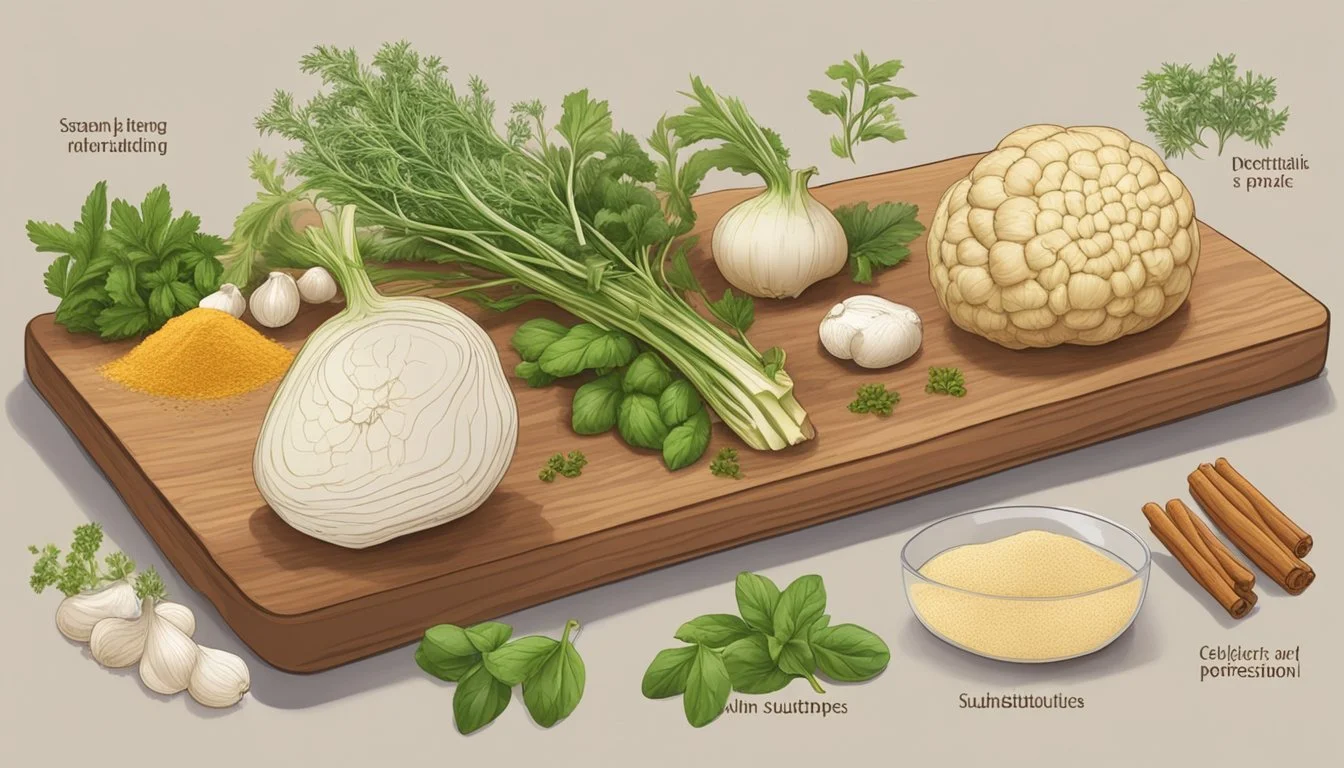Celeriac Substitutes
Best Alternatives for Cooking and Recipes
For those who love to cook with root vegetables, finding a good substitute for celeriac can be crucial when it’s not available. The distinct flavor and texture of celeriac can be replicated successfully using a variety of other ingredients. Parsnips, for instance, provide an earthy taste and tender texture, making them an excellent alternative in soups, stews, and baked dishes.
In addition to parsnips, other root vegetables such as daikon radish and kohlrabi offer unique benefits. Daikon radish has a milder flavor and can be used raw or cooked, while kohlrabi’s texture and slightly peppery flavor make it a versatile option. Carrots and turnips also serve as worthy substitutes due to their sweet and crunchy characteristics.
Selecting the right celeriac substitute depends on the dish being prepared and the desired flavor profile. Whether using parsnips for their earthy notes or kohlrabi for its nutritional content, having several alternatives ensures that your culinary creations remain delicious and satisfying regardless of ingredient availability.
Understanding Celeriac
Celeriac, also known as knob celery or Apium graveolens var. rapaceum, offers a unique flavor and texture that can be enjoyed both cooked and raw. It is a versatile vegetable with an earthy taste and numerous nutritional benefits.
What Is Celeriac
Celeriac is a root vegetable, closely related to celery but grown primarily for its bulbous root rather than its stalks. It has a rough, knobby surface with a creamy-white interior that becomes tender when cooked.
The flavor of celeriac is earthy and slightly nutty, with a hint of celery. It can be used raw in salads to add crunch or cooked in various ways, such as roasting, stewing, or mashing. Known for its versatility, celeriac can replace potatoes or other root vegetables in many recipes.
Cultivated mainly in Europe, celeriac is also gaining popularity in other parts of the world due to its distinctive taste and health benefits.
Nutritional Profile
Celeriac is low in calories but rich in essential nutrients, making it a healthy addition to any diet. It is an excellent source of vitamin K, which is vital for bone health and blood clotting. A 100-gram serving of celeriac provides about 42 micrograms of vitamin K.
In addition, celeriac contains significant amounts of vitamin C, phosphorus, and potassium. It offers dietary fiber, which aids in digestion and helps maintain a feeling of fullness. The vegetable's high water content also contributes to hydration.
Celeriac is free from cholesterol and low in fat, aligning well with heart-healthy dietary practices. The nutritional profile underscores the root's role in supporting various bodily functions and overall well-being.
Common Celeriac Substitutes
When celeriac is unavailable, or if you seek a different flavor profile, consider these substitutes: Parsley Root, Celery, Parsnip, Turnip, and Potato. Each offers unique characteristics and benefits, making them excellent alternatives for various culinary applications.
Parsley Root
Parsley root, often confused with parsnip, is an excellent substitute for celeriac. It has a similar earthy taste and a slightly sweet flavor. The texture is firm and starchy, making it suitable for soups, stews, and purees.
Parsley root is high in vitamins A, C, and K, plus essential minerals. It can be roasted, boiled, or mashed, maintaining its robust flavor through various cooking methods. For a comparable flavor, use it in equal amounts as you would celeriac.
Celery
Celery is a widely available substitute for celeriac. While it has a more pronounced crunchy texture and less starchy than celeriac, its slightly peppery and fresh flavor can suit many dishes. Celery can be used raw in salads or cooked in soups and stews.
Celery also provides vitamins A, K, and C, along with dietary fiber. When using celery as a celery root substitute, consider adding it along with another starchy vegetable like potatoes to replicate the texture of celeriac.
Parsnip
Parsnip is an excellent alternative due to its earthy taste and versatility. The texture is fibrous yet tender when cooked, making it ideal for similar dishes like soups, stews, and roasts. Parsnips become sweeter when cooked, adding a different but pleasant taste to the recipe.
Rich in dietary fiber, vitamins C and K, and folate, parsnips are not only a flavorful substitute but also a nutritious one. They can be used in a 1:1 ratio as a celery root substitute in most recipes.
Turnip
Turnip offers a slight peppery and sweet flavor, making it a useful substitute for celeriac. It has a dense and firm texture that holds well when roasted or boiled. Turnips work well in purees, soups, and mixed vegetable dishes.
Nutritionally, turnips are an excellent source of vitamin C, potassium, and dietary fiber. When substituting for celeriac, use turnips in equal amounts and adjust your seasonings to balance their slightly more pronounced taste.
Potato
Potato is a versatile and commonly available substitute for celeriac. It lacks the unique flavor of celeriac but has a similar starchy texture, making it suitable in a variety of dishes like soups, stews, and mashes. Potatoes provide a neutral flavor base that can complement a range of seasonings and ingredients.
Rich in vitamin C, potassium, and vitamin B6, potatoes are nutritious and easy to work with. Use them in equal parts as celeriac, and consider combining with another flavor-enhancing vegetable like parsley root or celery for a closer match to celeriac’s complexity.
Criteria for Choosing a Substitute
Choosing the right celeriac substitute involves considering flavor compatibility, texture match, and color considerations. Each factor plays a significant role in ensuring the alternative enhances the dish without compromising its overall integrity.
Flavor Compatibility
Flavor compatibility is crucial when selecting a celeriac substitute. Celeriac has an earthy, mild, and slightly sweet taste.
Parsnip, with its earthy and slightly sweet flavor, is a suitable alternative. Carrots or white carrots can also replace celeriac with their sweet taste, ideal for both raw and cooked dishes. Turnips and rutabaga offer a more robust, peppery flavor, making them excellent for roasted dishes or hearty soups.
Choosing a substitute that harmonizes with the dish's flavor profile ensures the final outcome remains delicious and balanced.
Texture Match
Matching the texture of celeriac is essential, as it affects the dish's mouthfeel and overall experience. Celeriac provides a unique combination of crispness when raw and tenderness when cooked.
Jicama offers a crisp texture, making it a good choice for raw salads. When cooked, it retains a pleasant crunch. Kohlrabi, high in calcium and magnesium, mirrors celeriac's texture both raw and cooked, with a slight peppery note.
Parsnips and carrots become tender when cooked, similar to celeriac, enhancing the dish's consistency without altering its desired texture.
Color Considerations
While color might seem secondary, it can influence the visual appeal of a dish. Celeriac typically off-white to pale brown.
Parsnips have a similar pale color, blending seamlessly in most recipes. Carrots add a bright orange hue, which can be visually appealing in many dishes.
Turnips and rutabaga come in various shades, from white to yellowish, and can work well depending on the dish's presentation needs. Kohlrabi's pale green appearance may also complement a variety of recipes, preserving the dish's aesthetic appeal.
Selecting a substitute with an appropriate color ensures the dish looks as good as it tastes.
Creative Alternatives for Celeriac
For those looking to replace celeriac in their recipes, there are several viable and flavorful alternatives. Among these, sweet potatoes and pumpkin add a hint of sweetness, while carrots and turnips offer a crunchy texture. Fennel bulb and kohlrabi bring a unique twist with their distinct flavors.
Sweet Potatoes and Pumpkin
Sweet potatoes offer a mildly sweet flavor that complements various dishes. They have a moist texture when cooked, making them an excellent option for soups and stews. Pumpkin, with its creamy consistency, can also work well in purees and roasted dishes. Both can substitute celeriac in equal amounts.
To enhance the dish, consider using them in combination with spices like cinnamon or nutmeg to bring out their natural sweetness. This pair is particularly good for autumnal recipes and adds a vibrant color to any dish.
Carrots and Turnips
Carrots and turnips are common kitchen staples that serve as practical celeriac substitutes. Carrots are known for their sweet taste and versatility—they can be used raw in salads or cooked in soups and casseroles. Turnips bring a slightly peppery taste and a firm texture.
Both can be sliced, diced, or shredded based on the dish requirements. Carrots add a touch of sweetness, while turnips provide a robust flavor. Mixing these two can yield a balanced taste profile, similar to that of celeriac.
Fennel Bulb and Kohlrabi
The fennel bulb provides a subtle anise flavor, making it a unique choice for recipes requiring celeriac. Its crisp texture is well-suited for salads, and it becomes tender when cooked, enhancing soups and stews. Kohlrabi, known for its mild, slightly sweet taste, can be used both raw and cooked.
Kohlrabi adds a crunch similar to that of celeriac and works particularly well in slaws or roasted vegetable medleys. Both fennel bulb and kohlrabi bring distinctive flavors that can elevate traditional dishes, making them ideal choices for culinary exploration.
Utilizing Celeriac Substitutes
Celeriac, or celery root, often needs substitutes due to its unique flavor and texture. Various alternatives can be utilized effectively in soups, stews, salads, raw dishes, roasting, and mashes.
Substitutes in Soups and Stews
When replacing celeriac in soups and stews, potatoes and turnips work well due to their similar texture. Both of these vegetables absorb flavors from the broth, enhancing the dish. Parsnips provide a slightly sweeter note, complementing savory ingredients.
Carrots can also be used, adding both sweetness and color. In hearty soups and stews, adding a blend of butternut squash and sweet potatoes creates a creamy consistency. Ensure to chop these substitutes into similar sizes to celeriac chunks for even cooking.
Alternatives for Salads and Raw Dishes
For salads and raw dishes, celery stalks and jicama offer a crunchy texture. Radishes provide a peppery bite, which can mimic the mild spiciness of raw celeriac. Thinly sliced kohlrabi serves as another suitable option.
Apple slices can be paired with these vegetables to add a touch of sweetness. Mixing these substitutes can create a diverse flavor profile. Ensure they're cut thinly to achieve the refreshing crunch desired in salads.
Using Substitutes in Roasting and Mashes
Roasting and mashing celeriac is common, and substitutes such as rutabaga and potatoes yield similar results. Both mash smoothly and achieve a creamy texture when combined with butter and cream.
Butternut squash and carrots can also be roasted to a caramelized finish, bringing out their natural sweetness. When mashing, consider adding parsnips for a subtly sweet and earthy flavor. Roasted turnips blend well with potatoes for a rich, satisfying mash.
These techniques help maintain the integrity of a dish, even without celeriac. By choosing the right substitute based on preparation method, the desired taste and texture can still be achieved.
Seasoning Adjustments When Substituting
When substituting celeriac in recipes, it is essential to adjust seasonings to match its unique earthy tone and balance the sweetness and spiciness of the alternatives. Consider specific herbs and spices to complement the chosen substitutes effectively.
Matching the Earthy Tone of Celeriac
Celeriac has a distinctive earthy flavor that may need enhancing when using substitutes. For parsnips, which share its earthy undertone, ground celery seeds or celery salt can help replicate the subtle celery-like taste.
Jicama, being milder, benefits from extra pepper or a dash of ground celery seeds to bring out a deeper flavor. When using fennel bulb, consider incorporating ground fennel seeds to reinforce the earthiness.
Balancing Sweetness and Spiciness
Substitutes like carrots and parsnips introduce sweetness that may require additional seasonings to avoid overwhelming the dish. Adding a bit of celery salt can balance the sweetness while maintaining a savory edge.
For spicier alternatives like turnip or rutabaga, adjust the level of black pepper and consider using a stronger herb such as thyme or rosemary to achieve the right balance. Be mindful not to over-spice, preserving the intended flavor harmony.
Herbs and Spices to Complement Substitutes
Different substitutes benefit from specific herbs and spices that best highlight their taste profile. Parsnips pair well with nutmeg and cinnamon, adding warmth without losing the earthy essence. Jicama shines with fresh cilantro and a sprinkle of chili powder to enhance its crispness.
The fennel bulb’s anise-like flavor pairs beautifully with dill or parsley, enhancing the overall dish. Consider using turmeric or cumin for turnips and rutabagas to underline their peppery notes while providing a fragrant backdrop.
Adjusting seasonings thoughtfully ensures that the substitutes serve their purpose effectively, maintaining the dish's intended flavor profile.
Shopping Guide for Celeriac Substitutes
Finding suitable celeriac substitutes is essential for recipes that rely on its unique flavor and texture. Key considerations include the availability of substitutes and criteria for selecting the best options based on your specific needs.
Where to Find Substitutes
Celeriac substitutes can be found in most grocery stores and markets. Parsnip and carrots, including white carrots, are typically readily available in the produce section. Kohlrabi and jicama may require a visit to specialty or international markets, especially if your local grocery store has a limited selection of less common vegetables.
When shopping, prioritize freshness. Both parsnip and kohlrabi should feel firm to the touch, with no soft spots or blemishes. For turnip and rutabaga, assure that their earthy taste and peppery bite remain intact by selecting unblemished and firm specimens. Jicama should look like a small, smooth potato and be free from shriveling.
Selecting the Best Substitutes
Choosing the right celeriac substitute depends on your culinary needs. Parsnip works well in soups, stews, and baked dishes, offering an earthy taste that closely mirrors celeriac. Kohlrabi provides a similar crunch whether raw or cooked, making it versatile for salads and casseroles.
For a slightly sweeter flavor, carrots and white carrots can replace celeriac in both raw and cooked recipes. Opt for turnip and rutabaga for their firm texture and peppery flavor, suitable for roasting and purees. Lastly, jicama adds a crisp, fresh texture perfect for salads and slaws, resembling raw celeriac with a slight sweetness.
Each substitute offers distinct qualities that can elevate your dishes while maintaining desired texture and flavor profiles.








